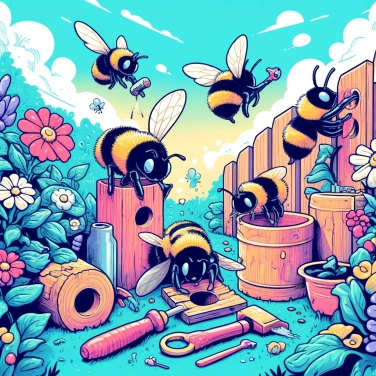Bumblebees plug the holes leading to their nest to ensure the safety of the colony and protect the queen and larvae from potential predators or intruders.

When bumblebees plug holes, they primarily aim to protect their nest and the larvae within it. It's mostly a matter of security: keeping intruders — parasites, predators, or even other opportunistic insects — out of reach. Another practical trick: the plug helps to regulate the internal temperature of the nest, maintaining an ideal thermal condition for raising the young. A well-sealed nest also prevents excessive moisture, which is crucial to avoid the larvae developing diseases and fungi. In short, for bumblebees, plugging a hole is like locking their door.
Bumblebees generally use materials they find nearby to effectively seal the holes in their nests. Often, they collect pieces of leaves, twigs, or even plant moss, which they grind with their jaws. They turn it all into a thick, compact, and durable paste for a watertight result. Some bumblebees even add moist soil or clay to further strengthen the plug. This mixture then dries naturally, solidifying the entrance of the hole to protect the entire colony inside.
This particular behavior of bumblebees has its roots in natural selection. For a long time, colonies of bumblebees that tended to seal the openings in their nests were more resistant to predators or parasites. Those that did not were more vulnerable and consequently disappeared faster. Little by little, generation after generation, individuals capable of effectively performing this task survived better, reproduced more, and it became a true behavioral trait embedded in their genetic heritage. Essentially, this small reflex to seal the holes is a winning strategy adopted by evolution: either you seal it, or you get eaten!
When bumblebees plug the holes, they shape the ecosystem in their own way. By closing certain cavities, they limit access to other competing or parasitic insects, which has a direct influence on local biodiversity. This notably controls the presence of certain invasive or harmful species. Their plugs also protect their nests and promote the survival of colonies, ensuring a key role in the pollination of surrounding plants. Fewer harmful parasites, stronger colonies, that means more pollinated flowers and, ultimately, better health for all local vegetation. Handy, right?
Recent studies show that bumblebees carefully choose their materials to seal holes, especially favoring a mix of wax and plant resin. This natural combo provides excellent sealing and even protects against certain diseases. Moreover, researchers have demonstrated that bumblebees that take the time to properly seal their entrances significantly increase the overall survival of their colony. Another interesting fact: in the lab, when insects are prevented from using their usual method to close the nest, the colony quickly becomes vulnerable to all sorts of external disturbances, including parasites and predators. Scientists have concluded that this sealing technique truly plays a key role in the ecological stability of colonies.
Some studies indicate that bumblebees can recognize holes that need immediate sealing based on the air currents and light detected inside the nest.
A bumblebee nest can contain up to 400 individuals; sealing the holes helps maintain optimal temperature and humidity for the development of the larvae.
The behavior of bumblebees is studied by aerospace and thermoregulation engineers to improve the passive ventilation of eco-friendly buildings.
By sealing off unused secondary entrances, bumblebees maximize their energy savings, limiting the risks associated with thermal regulation and opportunistic predators.
Bumblebees generally use readily available natural materials such as mud, plant resins, or fragments of leaves and other vegetation collected from their immediate environment.
Sure! Here’s the translation: "Yes, when bumblebees block cavities in trees or other structures, they indirectly alter access to these spaces for other insects or small animals, which can impact the local ecosystem balance."
Scientists often use direct observations, supported by video recording devices, as well as controlled experiments to analyze the motivations, techniques, and ecological consequences of plugging behavior in bumblebees.
No, although other species of bees, particularly solitary bees, exhibit similar behavior, the method and reason for blocking can vary significantly depending on the species and their environment.
No, bumblebees primarily plug the holes in their nests or in nearby cavities to regulate temperature, protect their larvae, and prevent the entry of predators or parasites.

No one has answered this quiz yet, be the first!' :-)
Question 1/5